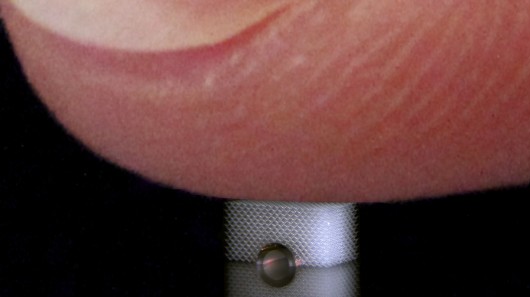New "invisibility cloak" keeps objects from being felt
By Richard Moss
July 1, 2014

It's now possible to hide an object from being felt, thanks to research by scientists at Karlsruhe Institute of Technology (Photo: T Bückmann / KIT)
Scientists at Karlsruhe Institute of Technology have developed a method of concealing objects from the sensation of touch that would finally meet the exacting standards of Hans Christian Andersen's fairy tale princess, who felt a single pea prodding her beneath 20 mattresses and 20 feather beds.
The research team's method relies on a metamaterial – a material that exhibits properties not usually found in natural materials – that consists of a three-dimensional polymer microstructure formed by needle-shaped cones. This metamaterial structure is built around the object to be hidden, with its mechanical properties dictated by those of the object.
Cloaking requires that an object be isolated from, and made to externally appear just like, its surroundings for all conditions. In optics, this feat is accomplished with help from an opaque metal wall, and in heat conduction by a thermally insulating wall. To make an "unfeelability cloak," you need a rigid wall around which a structure can be wrapped to make the interior feel identical to the surrounding.
The researchers placed a hard cylinder beneath the spring-like elastic metamaterial and found it to be undetectable to the touch of a finger or through tactile pressure with a measurement instrument. It was, to all intents and purposes, "invisible," as was anything placed inside the hollow interior.
This is distinct from, say, cotton or light foam placed atop the cylinder in that those materials would make it more difficult to touch the underlying hard material without negating the feeling that it's nonetheless there. In the Princess and the pea fairy tale, lead researcher on the project Tiemo Bückmann explains, "the princess feels the pea in spite of the mattresses. When using our new material, however, one mattress would be sufficient for the princess to sleep well."
The method could have far-reaching implications, allowing carpets to hide cables and pipes, or the manufacture of ultra-thin camping mattresses that soften the painful effects of sleeping on top of rocks, sticks, and uneven ground.
Don't expect to see it in use anytime soon, though. The research is little more than a proof of concept for elasto-mechanical cloaking, and as such will need a few years to mature into something commercially viable.
The research is described in a paper published in the journal Nature.
Source: Karlsruhe Institute of Technology
Copyright © Gizmag 2003 - 2014
